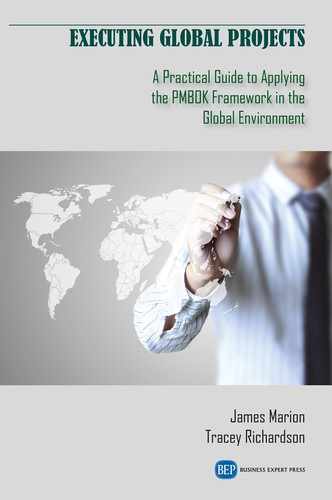The idea of the global project scorecard is borrowed from Kaplan and Norton’s “Balanced Scorecard.” The Balanced Scorecard seeks to assess the performance of an organization in a holistic manner rather than on profit and loss alone (Figure 13.1) (Kaplan, and Norton 1992).

Figure 13.1 The balanced scorecard
The Balanced Scorecard therefore measures company performance in terms of financial measures, internal and external measures (internal processes versus customers), and finally, learning and growth. The global project management scorecard builds on this idea, but rather than capturing performance measures, the scorecard seeks to establish readiness, capability—or said another way—maturity. In this respect, the global project scorecard holds an affinity with the project management maturity model known as OPM3. Maturity models in general could be compared in terms of human development as follows:
Sit: Do we have a process?
Stand: Is it documented?
Walk: Do we follow it?
Run: Does everyone know about it and use it?
Train: Are we optimizing our processes?
The sequence associated with the development of maturity may be a lengthy one. It takes time—beginning from the recognition of the need for process and the development of the process. It is not uncommon for project teams to lack processes for managing projects in the global environment. Developing and growing expertise begins with recognizing what is lacking and then building it.
This corresponds to the OPM3 levels of standardize, measure, control, and continuously improve (Figure 13.2) (Schlichter 2003).

Figure 13.2 Project Management and OPM3
The Elements of the Global Project Scorecard
Whereas the balanced scorecard assesses company performance via its financial, customer, internal process, and learning elements, the global project scorecard assesses the capability of the project to plan and execute projects that address the political, economic, social, and technological (PEST) elements of the countries and cultures with which the team will engage. More specifically, the global project scorecard evaluates the ability and process maturity to carry out the five processes of the virtual “Global Project Factor Management Knowledge Area” including the following processes as previously described:
- Identify the global project factor impacts
- Conduct a global project SWOT analysis
- Plan management of global project factors
- Identify the global risk factors
- Plan the global risk factor responses
The categories for which a project assesses its global capability is further broken down so that the detail for each PEST category is not overlooked (Figure 13.3).

Figure 13.3 Global project scorecard
